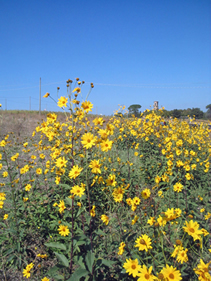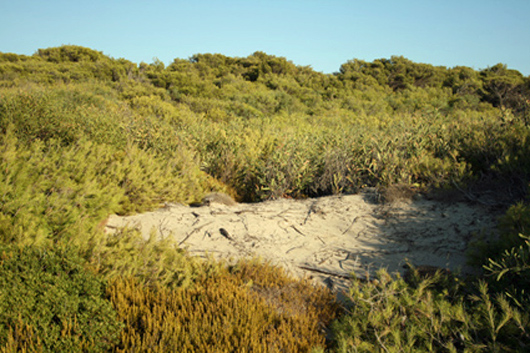Europe: Preventing the introduction of pest plant species in Mediterranean Europe
18.06.10
The spread of invasive alien species within Europe is a great and growing concern, writes Janette Fiddes.
The capacity to predict invasiveness of plant species is important for the conservation and management of natural ecosystems. Several Communications, Directives, Conventions (CBD, Bern Convention) and Strategies signed by European States recommend to strictly control the introduction of non-native species and prevent accidental introductions.
A recent study published in the June 2010 issue of the journal Biological Invasions follows the needs of the mentioned legislative acts validating the effectiveness of a Weed Risk Assessment (WRA) adapted for Mediterranean Europe. Many countries in the world have already adopted a WRA with the purpose of identifying high-risk species, thereby allowing decision-making on prevention and eradication so as to avoid ecological and economic harm.
Artificial selection for agricultural and horticulturally advantageous traits, such as greater fecundity, pest resistance, growth rates and geographical range may increase invasiveness capacity.

Helianthus tuberosus - Jerusalem artichoke - colonising an old field system. A very easy plant to grow, this trait lends means it is also a successful invasive weed in certain situations.
In particular, biofuel crops, which many countries are promoting as an alternative to fossil fuels, have many traits in common with the ideotype of an invasive species. Planting large quantities of vigorous plant varieties on a large scale by repeated introductions, often supported payment schemes, in different climates and soil conditions increases the likelihood of “crop escape”, and subsequent, establishment of new biological invaders.
Within this framework, ISPRA (the Italian Research Institute lead by the Ministry of the Environment) developed Weed Risk Assessment (WRA), specific to Mediterranean Italy with the aim to assess the potential harm of the biofuel species cropping system.
While the biology and ecology of weed species are important aspects that aid recognition of the potential for invasion, an elaborate Weed Risk Assessment may help to determine which new crop should be considered a potential pest.
The screening was adapted from the Australian Weed Risk Assessment System which is used to regulate the importation of new plant species and has been used for longer and more widely than any other predictive model for invasive plants.
The adaptation of the WRA provided good accuracy for prediction across different life forms; with the support of the secondary screening tool, was able to correctly classify, as accepted or rejected, 95% of the species.
When the WRA was undertaken to assess biofuel species, the final results showed that at least 60% of the species are potentially invasive. Of these species some are already considered weeds in Italy (Acacia saligna, Ailanthus altissima, Helianthus tuberosus, Robinia pseudoacacia). Some are weeds elsewhere and there is at present no real cropping system in Italy (Jatropha curcus, Kochia scoparia, Miscanthus sinensis), while others have a native wild relative (Cynara cardunculus var. altilis).

Acacia invasion on a dune system in southern Italy.
The authors of the paper endorse its use as a screening tool; for Mediterranean Europe, the WRA process could be used as a pre-entry screen for new biofuel crops with weedy tendencies. In addition WRA process may also be used as a management tool to control and reduce the proliferation of weed species that are already present in farmlands and that may harm biodiversity in agro-ecosystems. Targeting specific species, already identified in a WRA as potentially invasive species, would also facilitate an Early Warning System ensuring that new and emerging invasive plants are easily identified. The WRA is particularly recommended for those regions in Mediterranean Europe that intend to introduce new cultivation crops for energy production. In fact, simply changing the climate and soil parameters and evaluating the invasiveness potential from cultivar selection is sufficient for evaluating the invasiveness potential of alien species in a specific region.
Crosti R. et al. (2010) Use of a weed risk assessment for the Mediterranean region of Central Italy to prevent loss of functionality and biodiversity in agro-ecosystems. Biological Invasions 12: 6 June, 2010
Related links:
Canary Islands: New legislation threatens already endangered plants
27.05.10
 A new legal framework proposed by Coalición Canaria threatens many of the already endangered species endemic to the Canary Islands. However, in a coordinated effort academics, political groups, and NGOs are campaigning against the new laws...
A new legal framework proposed by Coalición Canaria threatens many of the already endangered species endemic to the Canary Islands. However, in a coordinated effort academics, political groups, and NGOs are campaigning against the new laws...
Spain: Polygala balansae - only known European population under threat
06.05.10
 Researchers at the University of Granada (UGR) have studied the natural history and conservation status in Spain of the only known population of Polygala balansae in Europe, a thorny bush that can grow up to 1.5 metres high, and previously thought to be exclusive to Morocco.
Researchers at the University of Granada (UGR) have studied the natural history and conservation status in Spain of the only known population of Polygala balansae in Europe, a thorny bush that can grow up to 1.5 metres high, and previously thought to be exclusive to Morocco.
Saving the flora of Mediterranean islands
23.06.09
 Visitors to a Greek island in August, strolling to the beach through a parched olive grove, with only golden grasses and desiccated seed heads around their feet would find it hard to believe that only a few months earlier the ground had been covered in a carpet of wild flowers and herbs, stirred into life by the first winter rains. The countries of the Mediterranean basin share 25,000 different species of flowering plants and ferns and 60 per cent of these are found nowhere else on earth, making it one of the world’s biodiversity ‘hotspots’.
Visitors to a Greek island in August, strolling to the beach through a parched olive grove, with only golden grasses and desiccated seed heads around their feet would find it hard to believe that only a few months earlier the ground had been covered in a carpet of wild flowers and herbs, stirred into life by the first winter rains. The countries of the Mediterranean basin share 25,000 different species of flowering plants and ferns and 60 per cent of these are found nowhere else on earth, making it one of the world’s biodiversity ‘hotspots’.